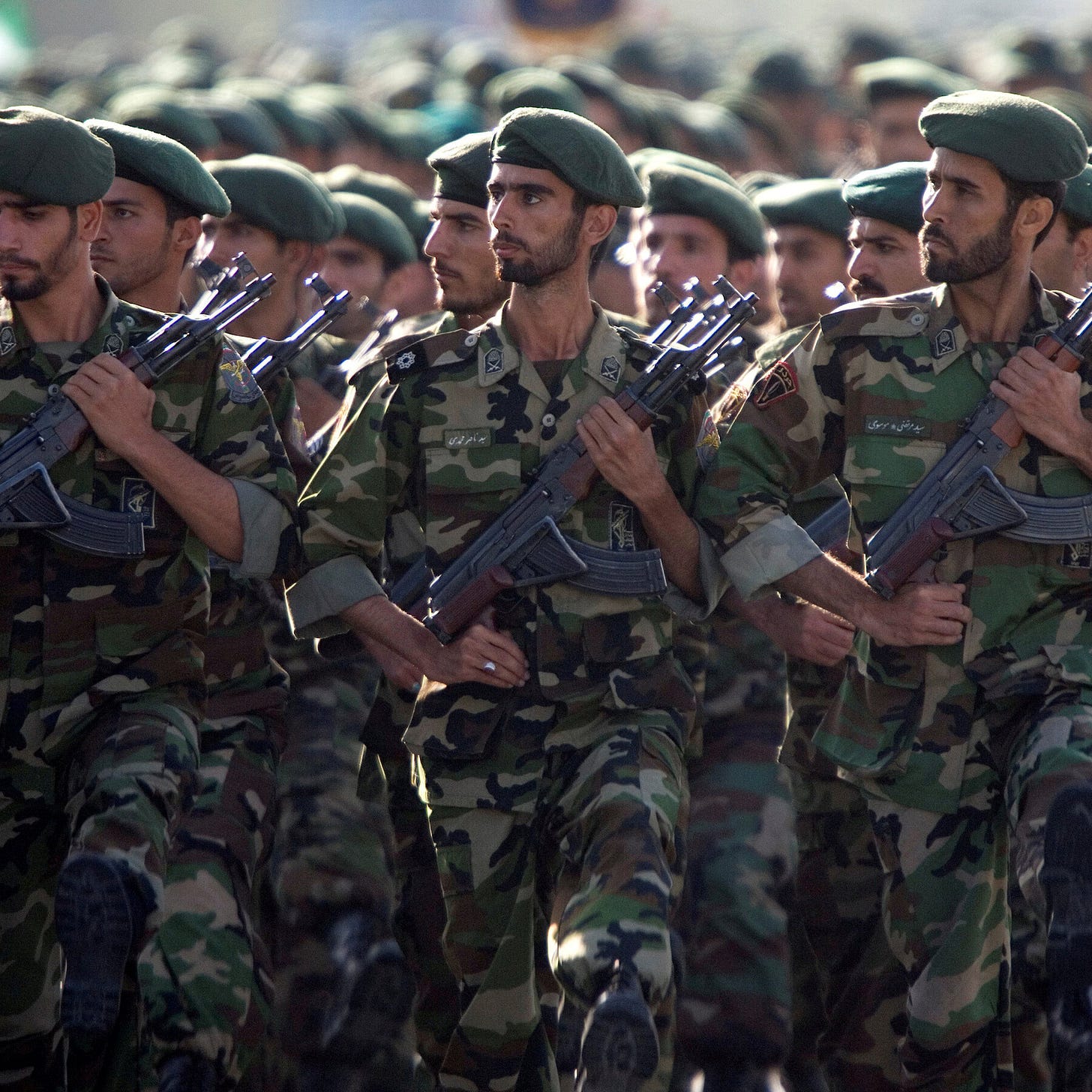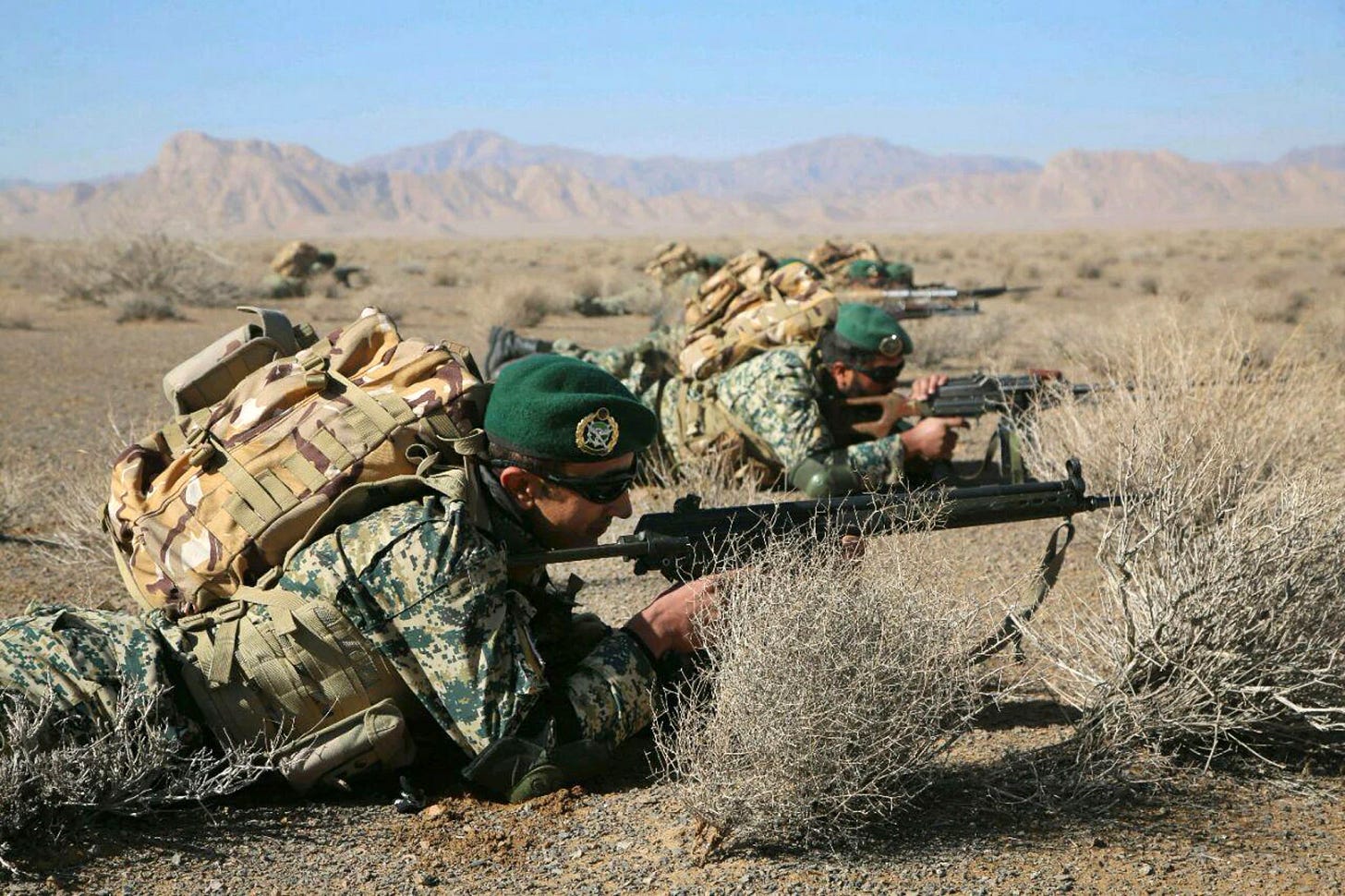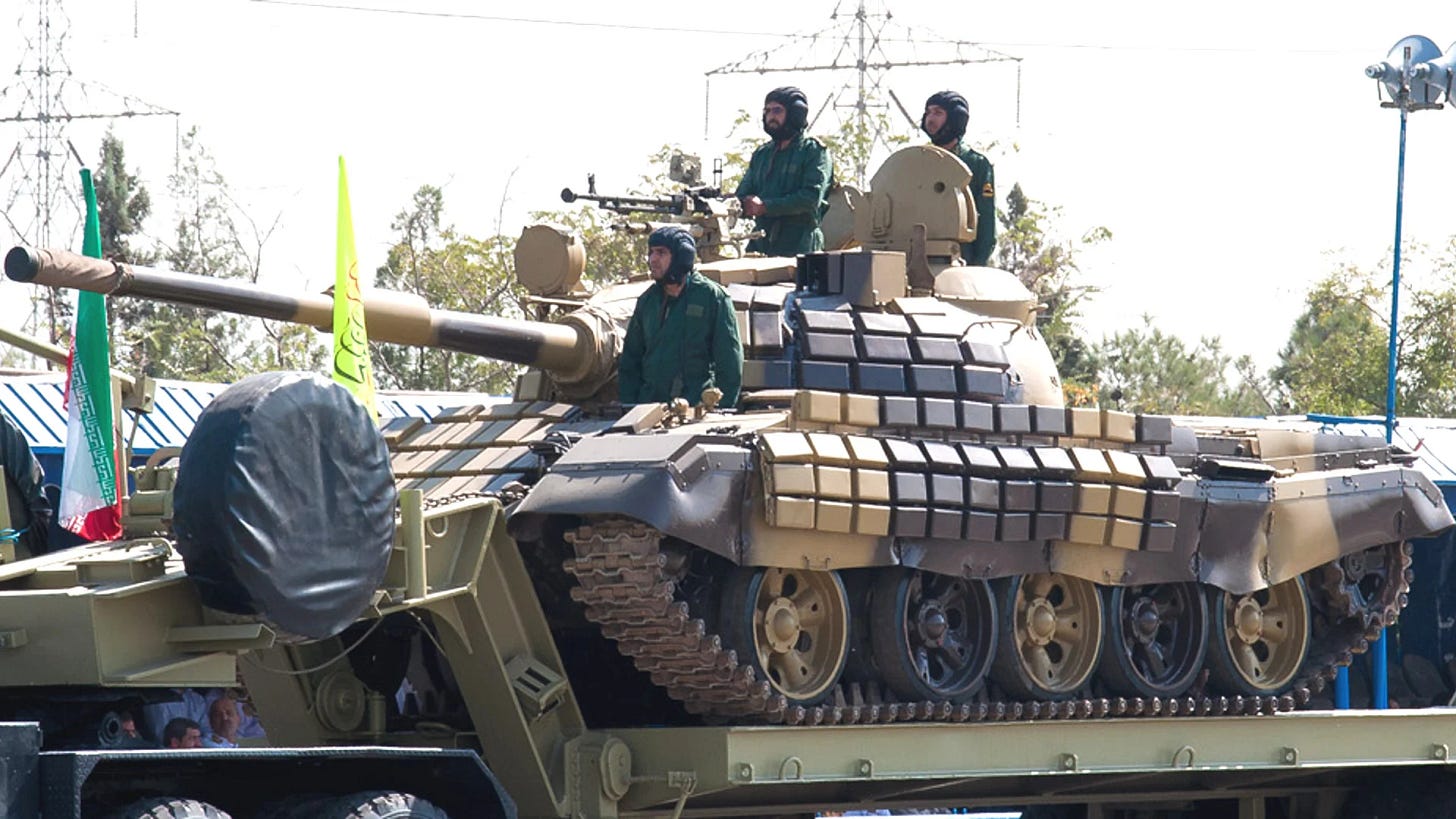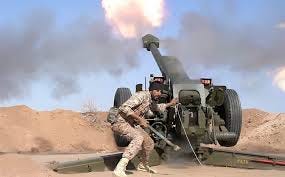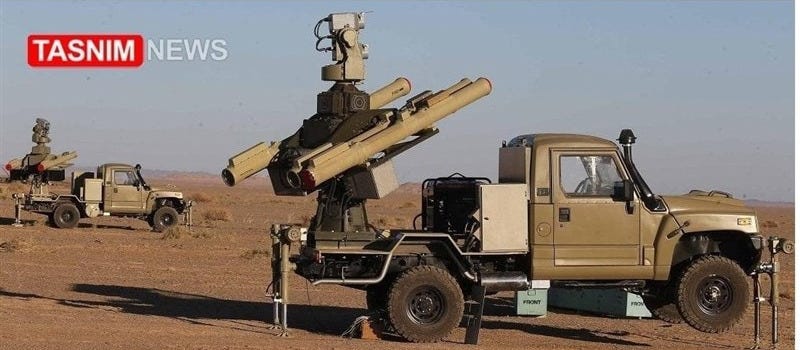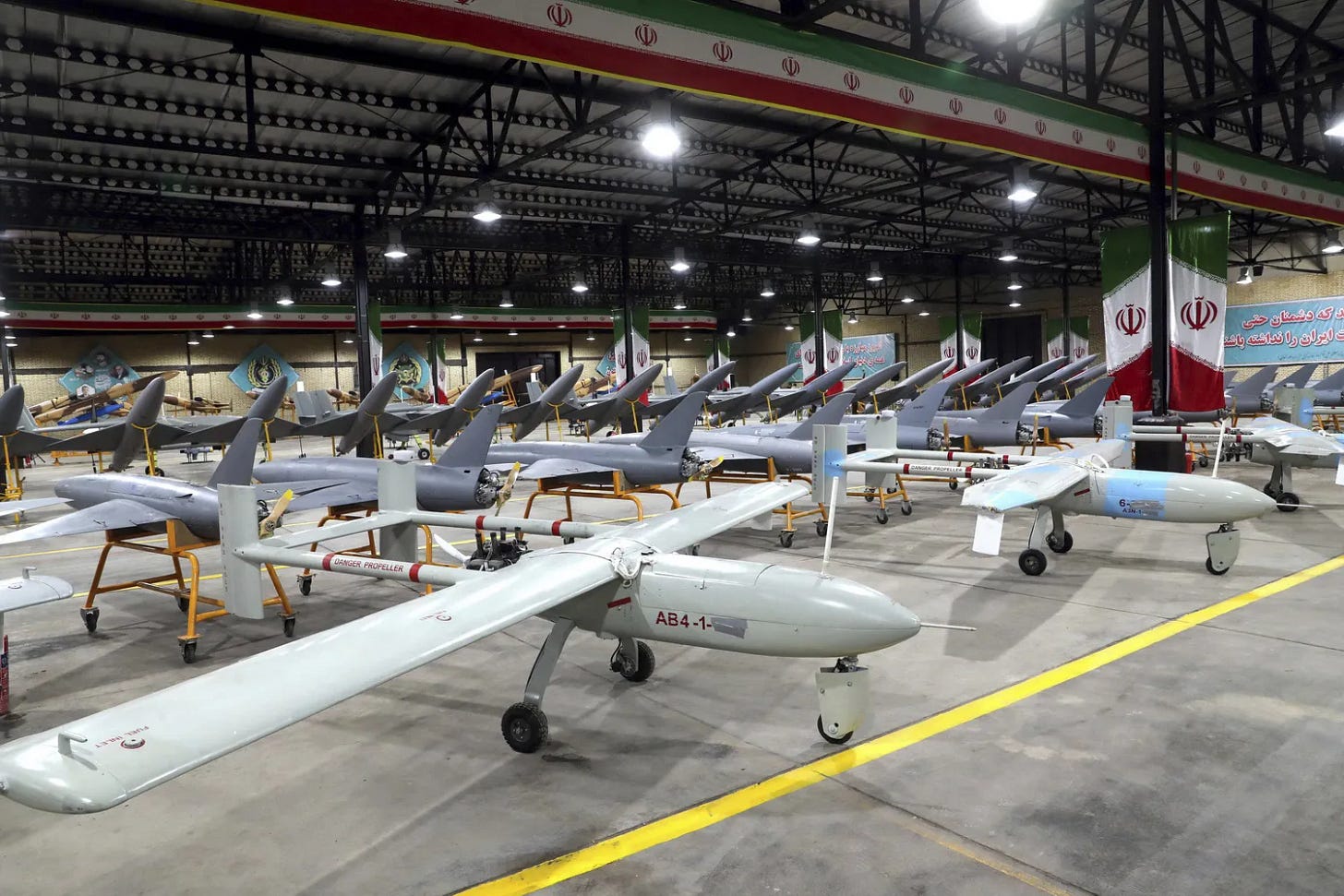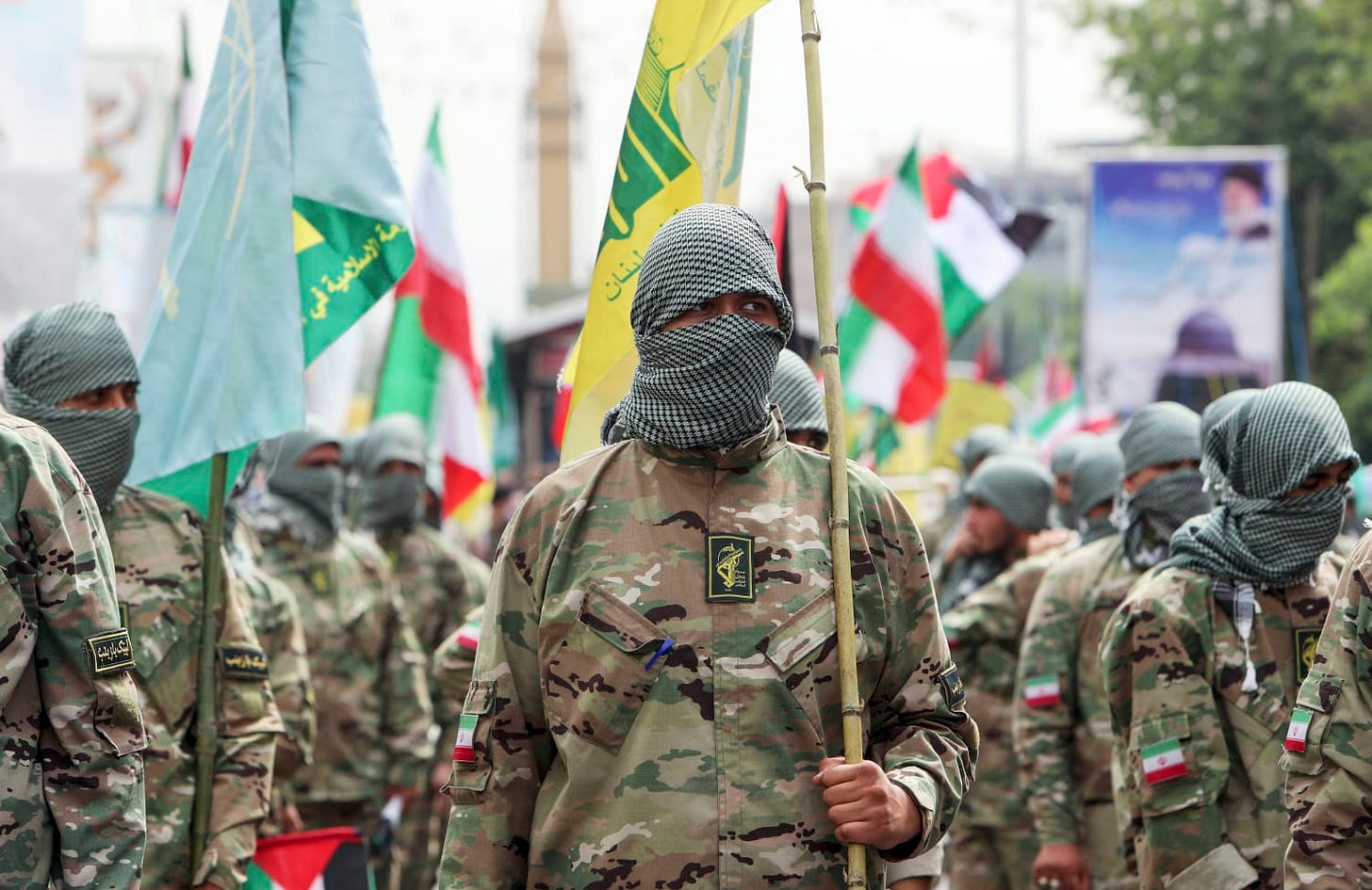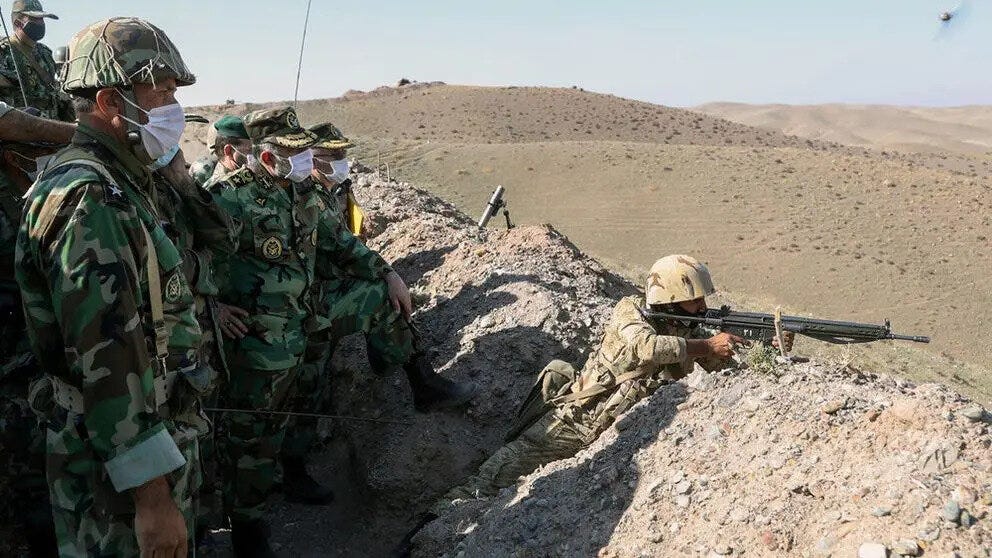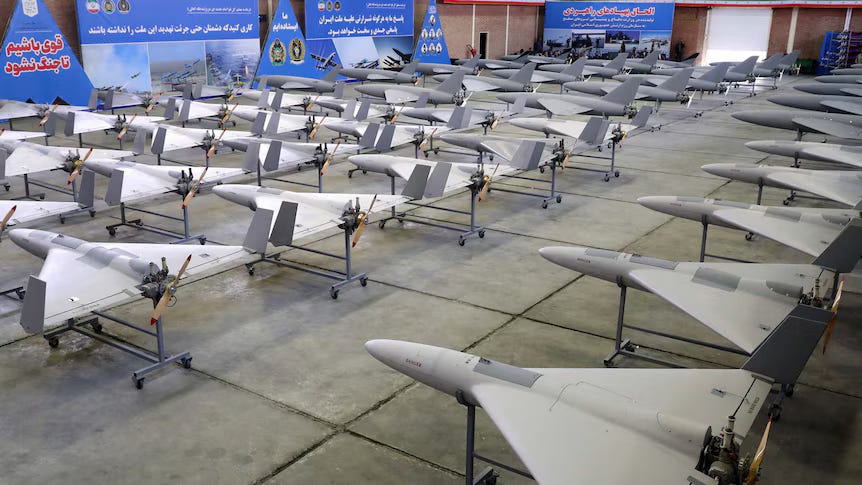Let's Invade Iran Part 2
Iran's Military
Having looked at the battle-space let’s take a look at the structure, equipment and capabilities of Iran’s armed forces.
The Iranian armed forces have clearly been organized and equipped around a rational strategy for deterring or resisting an American invasion. This strategy consists of:
Withdrawing to a National Redoubt in the mountains. The National Redoubt overcomes the lack of mechanized equipment and nullifies many of America’s advantages. However, it requires Iran surrender most of her oil fields in the early stages of the conflict;
The National Redoubt will be defended by large amounts of light infantry and a fairly capable artillery branch;
Rather than defending Iran’s airspace with aircraft, Iran would rely on a well invested air defence network to prevent America’s air-power from playing a decisive role. Long range strikes would come from Iran’s extensive domestic missile and drone industry; and
From the National Redoubt Iran would coordinate an asymmetric warfare campaign to wear down American resolve. In the occupied areas the Basji would act as a pre organized insurgency. Iran would also attack American domestically through cyber warfare on infrastructure, economic and political targets.
This hedgehog type defensive strategy takes advantage if Iran’s terrain. It is a good deterrent to invasion, as it makes an invasion of Iran potentially very costly. However, the strategy relies on two uncertain assumptions:
Iran’s domestic air defence system will prevent the US Air Force from playing a decisive role; and
The Iranian people will maintain resolve and support for their government in the face of a US invasion.
Iran’s Military Manpower
Iran has a regular force military of 592,000, about 1/3rd of which is the Revolutionary Guard. They are a parallel military force that is more ideologically aligned with the Islamic government, but they are generally considered to be higher quality soldiers with units having a lower percentage of conscripts. Iran also has a reserve of 390,000 recently discharged conscripts who would be called back into service in the event of mobilization. This gives Iran military with 982,000 uniformed personnel, which is the 14th largest military in the world.
Iran also has a pre organized insurgency force called the Basji, but that will be discussed in the section on the asymmetric strategy.
Iran’s Ground Forces (Structure)
In terms of structure the Iranian ground forces have 87 combat brigades.1 There is an emphasis on light infantry and special forces, with these categories making up about 75% Iran’s brigades. Armoured and mechanized infantry making up the other 25%. This is a logical force structure as light infantry are the most useful type of unit in mountainous terrain.
Several caveats are required. First, the number lists 22% of it’s brigades as being special forces. This is simply not credible. Many of the Revolutionary Guard’s special forces brigades are likely the military organization for Iranian controlled insurgency forces operating in other countries like Iraq. The true number of special forces type brigades in the Revolutionary Guard is probable closer to 3x.
Second, we need to consider what these Brigades mean in terms of combat power, as their size and equipment is considerably below western standards.
The world essentially has two types of manoeuvre brigade structures. In western nations manoeuvre brigades are built on companies of 120-180 soldiers, with the brigade having battalion sized engineer, artillery and logistics support. In eastern nations manoeuvre brigades are built on companies of 80-120 soldiers, with an artillery battalion, but only companies for engineers and logistics. The result is that western brigades tend to have 3,500 to 5,000 soldiers, versus 2,000 to 3,000 soldiers in eastern brigades.
Looking at the number of brigades versus number of soldiers the Iranian military they clearly operate on the eastern brigade model. Therefore to get a rough equivalent in strength of Iran’s Brigades we reduce them to 81 (to account for the foreign insurgency organization units) and then divide them in half.
Iran’s Ground Forces (Equipment)
Iran’s ground forces generally have equipment that is serviceable but viable for use in modern conflict, but obsolete by western standards.
In my video series on the Ukraine war I used the following categories for equipment:
A: Post Cold War Designs
B: Designed in the Late Cold War (1980s)
C: Designed in the Mid Cold War (1970s)
D: Designed in the Early Cold War (1960s)
By this measure most of Iran’s equipment is about equally split between category B and C. By comparison, western armies tend to have mostly category B equipment with some category A equipment.
Iran is particularly weak in armoured vehicles. They have a normal number of tanks given the size of their ground forces but they are all obsolete models. Their most modern tank is the T-72S, which was an expert version of the T-72 build without what the Soviet Union considered the more advanced features in the 1970s and 80s.
Given the size of Iran’s ground forces they have relatively few Infantry Fighting Vehicles (IFVs) and Armoured Personnel Carriers (APCs). Therefore they have a limited ability to rapidly move infantry under armoured protection on the battlefield.
The strength of Iran’s ground forces is in indirect fire assets. They hold a normal amount of artillery and mortars given their number of combat brigades, and it is modern enough to be effective against the US military. They have a large number of multiple launch rocket systems (MLRS).
The equipment for Iran’s ground forces is well suited to a strategy of defending the mountainous regions of the country. The lack of armoured vehicles is not a disadvantage on that type of terrain. Indirect fire weapons like artillery are particularly effective in mountainous terrain. Shells impacting on rock create additional shrapnel effect from rock splinters. Mountains create long lines of sight for artillery observers to direct fires while the indirect fire weapons are concealed in the shadow of mountains further in the rear. Iran’s mountainous regions are particularly suited to long range observation as most of them are not covered in forests.
Iran’s Air Force
Iran’s air force is not a serious threat to any modern western military. Since the 1979 revolution Iran has been under import sanctions that particularly prevented the aerospace sector.
The Iranian Air Force has a number of combat aircraft acquired prior to the 1979 revolution. Most notably this includes 40x F-14s, but they have not had the kind of upgrades required to keep them competitive, and due to a shortage of spare parts they are of questionable value.
Iran’s post 1979 aircraft consist of 30x Mig-29s, 32x Su-24s and 20x Su-22s. The Mig-29 is on the bottom end of competitive fighters. It is rugged and manoeuvrable, but western air forces can destroy the Mig-29 while staying outside the Mig-29’s engagement ranges. The Su-24 and Su-22 are still viable fighter-bombers, but once the Mig-29s are shot down they would be incapable of operating.
Iran’s Air Defence System
Given that Iran does not have a viable air force they rely on their aid defence system. Iran has a dedicated air defence force with 15,000 pers, which was split off from the air force in 2008. They are responsible for defence of Iran’s airspace and critical infrastructure. This means preventing an invader from gaining air superiority and protecting civilian targets like oil fields, transportation links and cities.
The army, Islamic Revolutionary Guard and navy also have tactical level air defence to protect their own forces.
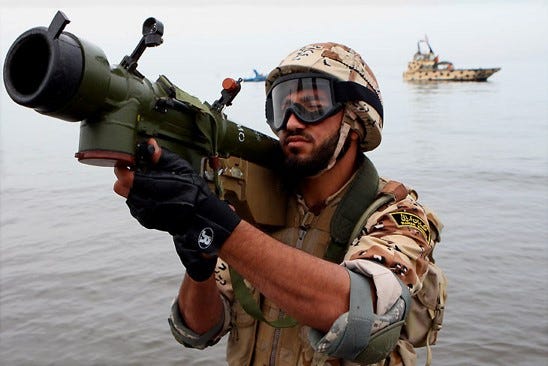
Iran has invested heavily in creating domestically manufactured air defence systems. This means their air defence systems are likely very capable, but it is hard to know how capable. The USA has a good sense of how western and former soviet systems function, because these systems are used by America’s allies. In this case Iran’s isolation from the international arms market has also provided them with significant operational security.
Iran most probably does not have the capability to shoot down stealth aircraft, but they can shoot down the guided munitions they release from a standoff distance. This means for operational and strategic level targets there would be a similar dynamic as in Ukraine over the last few years. The US releases standoff guided munitions, Iran’s air defences shoot down some of them, but not all. Iran’s operational and strategic infrastructure is constantly atritted and degraded. This interferes with Iran’s ability to defend the front line, but is not a war winner.
At the tactical level the Ukraine war has also been illustrative. Modern air defence systems mean air forces cannot roam the battlefield at will providing tactical air support. The US military’s used of air support on call used in all post-WW2 conflicts would not be viable in a war against Iran. Tactical air support is still a potent weapon, but it requires detailed prior planning for what’s called suppression of enemy air defence to open up a temporary corridor where tactical air assets can safely operate. For rapid response fire support of ground forces in contact with Iranian soldiers the US military would fall back on artillery and mortars.
The Asymmetric Strategy
It is clear from Iran’s force structure that their conventional military strategy is to withdraw into the mountain redoubt that encompasses about half it’s territory and most of it’s population. From this redoubt they would fight an attrition war while holding mountain passes with light infantry. The terrain, size of the country, size of Iran’s ground forces and limited road network makes this a viable strategy. US air power would interfere with this strategy, but it would not be a war winner on it’s own.
However, Iran could not hold out forever, and they would lose control of most of their oil fields by withdrawing from the open terrain near the Iraqi border. Therefore Iran has a complementary asymmetric strategy involving drones, precision missile strikes, insurgency and cyber warfare.
Along with a domestic air defence missile industry Iran has invested in drones and missiles for long range precision strikes. This capability has been on show in the various exchanges with Israel. In a US invasion these assets would likely be more effective. They would be used against US targets that are much closer, in places like Kuwait, Qatar and on occupied Iranian territory. The targets being closer means the US has less time to intercept than for the strikes on Israel.
Iran is also a world leader in cyber warfare. It’s generally acknowledged that the countries with the greatest cyber warfare capability are China, Russia, America, North Korea and Iran. I will not go into much detail due to the overlap with classified information I know, but Iran has the ability to inflict serious disruption on American infrastructure via cyber warfare.
The final aspect of Iran’s asymmetric strategy is the Niru-ye Moghāvemat-e Basij, which roughly translates as "Resistance Mobilization Force". The Basji is the paramilitary volunteer branch of the Revolutionary Guard. During peacetime they provide street level enforcement. During the various waves of unrest they are often seen with small arms putting down riots and protests.
It is widely believed that in the event of an invasion of Iran they would form a pre-organized insurgency. They are well suited to this role as a hierarchically organized group with members that are not indefinably in the military, ideologically reliable, armed and with a history of violence on behalf of the regime.
Conclusion - The Iranian Strategy
Combining Iran’s terrain with their force structure they clearly plan to fight a hybrid conventional/asymmetric was from a national redoubt in the mountains.
Their conventional military is not structured or equipped to seriously contest the limited open terrain near the Iraqi border. However, it is well equipped to fight a long and frustrating attrition war in the mountains. This would mean losing most of Iran’s oilfields at the outset of the conflict, but this cannot be avoided. Iran has little mechanized equipment relative to the size of it’s military, and that equipment would be outclassed by any first world army. By withdrawing to the mountains Iran can significantly nullify America’s superiority in mechanized equipment. To fight effectively in the mountains you only need light infantry and good artillery, both of which Iran has in large quantities.
America’s other great advantage is air power. Iran does have an air force, but not one that is a significant obstacle to US air superiority. Instead Iran has put a lot of resources into ground based air defence. It is difficult to assess the effectiveness of these air defence systems, as they are domestically manufactured and the Ukraine-Russia war is our only data point for modern air defence systems. Given that example we would expect the US Air Force could attrit Iran’s war effort, but this would not be war winning and the impact on front line combat would be minimal. Iran also relies on a domestic missile and drone industry to replace the kind of operational level strikes that are normally done by fighter bombers.
Iran would also harass America outside front lines through cyber wafrare attacks on the homeland and an insurgency force in occupied areas built around the Basji. The goal would be to inflict enough of a toll in blood, money and inconvenience for American public support to collapse.
Would this strategy be successful? It is very difficult to say. It relies a lot on air defence systems (which have not been combat tested) and the Iranian population remaining resolve. This type of hedgehog strategy exists as a deterrent to invasion, by making the likely cost of an invasion outweigh the US security establishments dislike of the Iranian regime.
When the US was preparing to invade Iraq in 2003 the Saddam regime made similar threats of a national redoubt that would evolve into a Vietnam type conflict. Unlike Iraq, Iran has the terrain, domestic industry and strategic depth to pull this strategy off, if (and this is a crucial condition) the Iranian people stand with their government in the face of a US invasion.
This would depend a lot on the event triggering an invasion, and is fundamentally a political question for a topic where I am largely ignorant. I can clearly state an invasion of Iran today would be a much longer, bloodier and harder undertaking than the 2003 invasion of Iraq. In the Iran-Iraq war Iran certainly showed the capacity to absorb the loss of her oil-fields and catastrophic casualty levels. However, that war ended two generations ago.
So what size of invasion force would America need to attempt an invasion of Iran? How might American planners estimate the size of invasion force? Where are the likely invasion routes and what political conditions are needed to use each invasion route? This will be addressed in Part 3 of Let’s Invade Iran.
A combat brigade is made up of infantry, armoured or special forces units.





